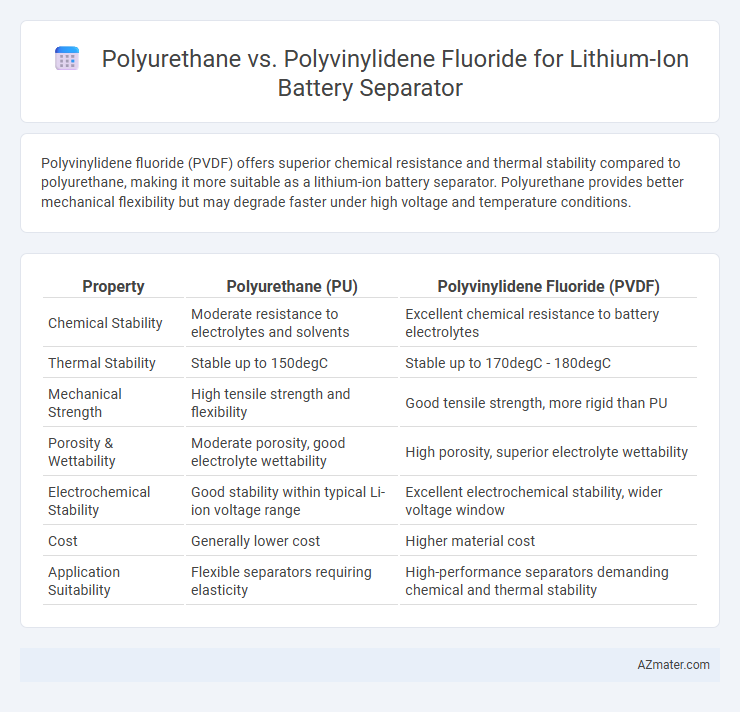Polyvinylidene fluoride (PVDF) offers superior chemical resistance and thermal stability compared to polyurethane, making it more suitable as a lithium-ion battery separator. Polyurethane provides better mechanical flexibility but may degrade faster under high voltage and temperature conditions.
Table of Comparison
| Property | Polyurethane (PU) | Polyvinylidene Fluoride (PVDF) |
|---|---|---|
| Chemical Stability | Moderate resistance to electrolytes and solvents | Excellent chemical resistance to battery electrolytes |
| Thermal Stability | Stable up to 150degC | Stable up to 170degC - 180degC |
| Mechanical Strength | High tensile strength and flexibility | Good tensile strength, more rigid than PU |
| Porosity & Wettability | Moderate porosity, good electrolyte wettability | High porosity, superior electrolyte wettability |
| Electrochemical Stability | Good stability within typical Li-ion voltage range | Excellent electrochemical stability, wider voltage window |
| Cost | Generally lower cost | Higher material cost |
| Application Suitability | Flexible separators requiring elasticity | High-performance separators demanding chemical and thermal stability |
Introduction to Lithium-ion Battery Separators
Lithium-ion battery separators are critical components that prevent physical contact between the anode and cathode while allowing ionic transport. Polyurethane (PU) offers high elasticity and excellent chemical stability, making it suitable for flexible battery designs, whereas Polyvinylidene Fluoride (PVDF) is favored for its superior thermal stability and strong electrochemical resistance. The choice between PU and PVDF influences the separator's porosity, mechanical strength, and overall battery performance.
Importance of Separator Materials in Battery Performance
Separator materials critically influence lithium-ion battery performance by ensuring ionic conductivity while preventing electrical short circuits. Polyurethane offers excellent mechanical flexibility and chemical stability, enhancing battery safety and cycle life. Polyvinylidene fluoride provides outstanding thermal stability and chemical resistance, making it ideal for high-performance separators in demanding applications.
Overview of Polyurethane as a Battery Separator
Polyurethane as a lithium-ion battery separator offers exceptional mechanical strength, high thermal stability, and excellent electrolyte wettability, enhancing ionic conductivity and battery safety. Its customizable polymer structure allows for tailored porosity and flexibility, improving separator durability under cycling stress. These properties make polyurethane a competitive alternative to conventional separators, contributing to improved battery lifespan and performance.
Overview of Polyvinylidene Fluoride (PVDF) as a Separator
Polyvinylidene Fluoride (PVDF) is widely used as a separator material in lithium-ion batteries due to its excellent chemical stability, high thermal resistance, and strong electrochemical performance. Its semi-crystalline structure provides excellent mechanical strength and enhances ion conductivity while maintaining safety by preventing dendrite penetration. PVDF separators also exhibit superior electrolyte wettability and chemical compatibility with lithium-ion battery electrolytes, contributing to improved battery cycle life and efficiency.
Mechanical Properties: Polyurethane vs PVDF
Polyurethane exhibits superior elasticity and tensile strength compared to polyvinylidene fluoride (PVDF), making it more resistant to mechanical stress and deformation in lithium-ion battery separators. PVDF, while offering good chemical stability and thermal resistance, tends to have lower elongation at break and less flexibility under dynamic load conditions. The enhanced mechanical properties of polyurethane contribute to improved separator durability and battery safety during repeated charge-discharge cycles.
Chemical Stability and Compatibility Comparison
Polyurethane exhibits excellent flexibility and mechanical strength but has limited chemical stability in aggressive electrolytes, often leading to degradation over prolonged lithium-ion battery operation. Polyvinylidene fluoride (PVDF) demonstrates superior chemical stability and compatibility with lithium-ion battery electrolytes, resisting oxidation and maintaining thermal stability under high voltage conditions. PVDF's inert nature ensures enhanced separator longevity and safer battery performance compared to polyurethane-based separators.
Thermal Properties and Safety Considerations
Polyurethane exhibits excellent flexibility and high thermal stability, with decomposition temperatures typically around 280degC, making it suitable for maintaining integrity under thermal abuse in lithium-ion battery separators. Polyvinylidene fluoride (PVDF) offers superior chemical resistance and a higher melting point near 170degC, providing enhanced safety by preventing separator shrinkage and thermal runaway risks during battery operation. The choice between polyurethane and PVDF in separators significantly impacts battery thermal management and safety, with PVDF often favored for its dimensional stability and flame retardant properties.
Electrochemical Performance Analysis
Polyurethane (PU) separators demonstrate superior electrolyte wettability and higher ionic conductivity compared to Polyvinylidene Fluoride (PVDF), resulting in enhanced lithium-ion transport and reduced internal resistance in lithium-ion batteries. Electrochemical impedance spectroscopy reveals PU's lower interfacial resistance, which contributes to improved cycling stability and rate capability. PVDF separators, while chemically stable, often suffer from lower porosity and electrolyte uptake, limiting their electrochemical performance in high-demand battery applications.
Cost and Manufacturing Considerations
Polyurethane separators offer lower material costs and simpler fabrication processes compared to polyvinylidene fluoride (PVDF), making them attractive for large-scale lithium-ion battery production. PVDF separators, while more expensive due to complex polymer synthesis and solvent requirements, provide superior chemical stability and thermal resistance essential for high-performance batteries. Manufacturing considerations favor polyurethane for cost-sensitive applications, whereas PVDF is preferred where enhanced safety and longevity justify higher production expenses.
Future Trends and Material Innovations
Future trends in lithium-ion battery separators emphasize enhanced thermal stability and mechanical strength, with polyurethane (PU) showing promise due to its excellent elasticity and chemical resistance. Polyvinylidene fluoride (PVDF) remains favored for its superior electrochemical stability and hydrophobic properties that improve electrolyte wettability. Innovations combining PU's flexibility with PVDF's durability, including composite membranes and nanofiber modifications, are driving next-generation separator development for higher energy density and safer battery performance.

Infographic: Polyurethane vs Polyvinylidene Fluoride for Lithium-ion Battery Separator
 azmater.com
azmater.com